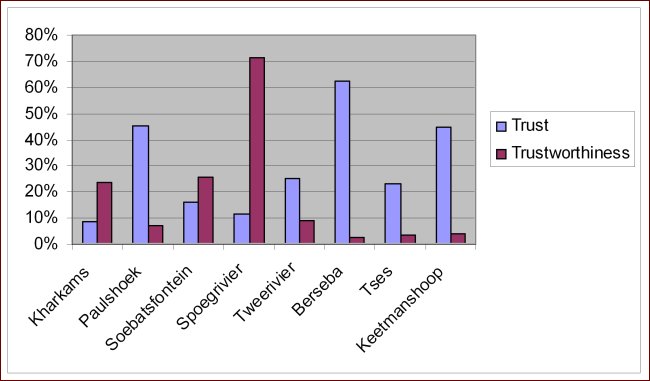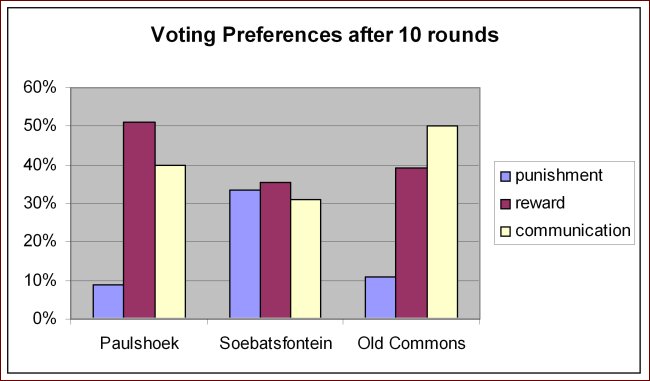|
|
|
 |
|
|
Socio economy: Nabaos 7
Reasons for economic field experiments |
Free-riding incentives are a pervasive phenomenon in social life. Participation in collective action or the prevention of negative environmental externalities, or the exploitation of a common resource are typical examples. In these cases the free rider cannot be excluded from the benefits of collective actions or the public good although he does not contribute. In view of the importance of cooperation problems in natural resource management it is crucial to understand the forces shaping people's cooperation. A key to the understanding of cooperation problems is the interaction between selfish individuals and individuals with other-regarding preferences (Fehr & Schmidt 2005). To elicit the relation between different individuals a combination of trust games, common-pool resource games and household surveys were conducted at BIOTA observatories in Namaqualand (Soebatsfontein, Paulshoek) and southern Namibia (Nabaos). |
Trust Games1 (2006) |
There is much recent theoretical and empirical evidence that trust between people fosters co-operation and plays an important role in any exchange relationship. Trust games are employed to investigate the effect of heterogeneity in income on cooperation in communities of the Namaqualand, southern Namibia and northern Namibia (Michael Pröpper). The level of trust is with an average of 28% as low (usually above 50%) as the average level of trustworthiness of 22% (see bar chart1 below). Interestingly, in villages were people exhibited higher levels of trust, their partners were extremely untrustworthy. Typically in trust games, a sizeable share of responders (frequently roughly 40 percent, sometimes more than 50 percent) exhibit a reciprocal effort pattern. In Namaqualand and Namibia however, reciprocal behaviour (i.e. being trustworthy when others trust you) is rather the exception. This behavioural pattern can help in understanding difficulties of enforcing non-binding verbal contracts. Further research will focus on gender, income, age and education differences on levels of trust.   Chart 1 Chart 1
1In a trust game, both an Investor and a Trustee receive an amount of money S from the experimenter. The Investor can send between zero and S to the Trustee.The experimenter then triples the amount sent, which we term y, so that the Trustee has S + 3y.The Trustee is then free to return anything between zero and S + 3y to the Investor. The Investor's payoff is S - y + z and that of the Trustee is S + 3y - z where z denotes the final transfer from the Trustee to the Investor. |
Common-pool resource games |
Our field experiments on common-pool resource use find (similar to other studies) that neither the socially optimal use can be achieved nor that the theoretical prediction, that users are trapped in inexorable tragedies (Hardin 1968) can be confirmed. More interestingly is the ongoing quest to identify contextual and other factors that help in achieving effective, decentralised and co-managed solutions for resource use. This study uses experimental data to test for efficiencies of formal regulations imposed on a community to conserve a local natural resource and non-binding verbal agreements to do the same. Our experiments were again conducted in the field in one region of South Africa and Namibia. Each group of five subjects played 10 rounds of a baseline common pool resource game (without communication or regulation), and 10 additional rounds under one of three institutions - communication alone, external regulations through either punishment or reward. Additionally after round 10 and 20 subjects were asked to vote for their preferred institution. All second stage institutions were effective in reducing individual harvests from the open-access baseline (see chart 2 below). However, there is a remarkable difference to similar studies, that subjects do better in external regulations than in the communication scenario.   Chart 2
Other results show interesting differences between the BIOTA observatories. In Paulshoek, a village with a long history of communal land tenure, the preferred institutions are either "reward" or "communication" and extraction levels are throughout higher than in Soebatsfontein, a village which only got their land for communal land use in 2000. Strikingly, villagers in Soebatsfontein see "punishment" as an equally viable strategy to govern their newly obtained communal land.(see chart 3 below) Chart 2
Other results show interesting differences between the BIOTA observatories. In Paulshoek, a village with a long history of communal land tenure, the preferred institutions are either "reward" or "communication" and extraction levels are throughout higher than in Soebatsfontein, a village which only got their land for communal land use in 2000. Strikingly, villagers in Soebatsfontein see "punishment" as an equally viable strategy to govern their newly obtained communal land.(see chart 3 below)   Chart 3 Chart 3
|
Household Survey on Demographics and dimensions of Social Capital (2004/2005) |
With combining the household surveys and the results from the experiments it will be tried to explain the considerable individual differences and differences at village level among the Responders. An analysis of the survey has been done and elements of it presented at workshops and conferences (see list below). Main results for the Namaqualand is the short-term crowding-out effect of trust and reciprocity through the establishment of a high amount of user groups in a village as well as an advantage in formal collective decision-making processes of villages in the old commons due to a stronger embeddedness in local traditions. |
Publications |
Vollan, B.: "The role of user committees for the devolution process in Namaqualand" paper presented at the 11th Biennial Conference of the international Association for the study of Common Property in Ubud, Bali/Indonesia, 2006.Vollan, B.: "The Emergence and Erosion of Norms in a common-pool resource system. Findings and open questions from the fieldwork in Namaqualand, South Africa." paper presented at the International Workshop on Evolutionary Economics 2005, Buchenbach, 2005.Vollan, B., Bock, B., Kirk, M.: "Efficiency or Fairness? Strategies, Conflicts, and Dynamics in the Commons as Reaction Towards Increasing Pressure from Globalization" paper presented at the Tropentag 2005, Hohenheim, 2005. |
|
|
|
